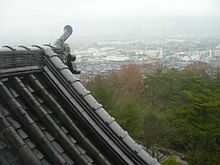Mie Prefecture
| Mie Prefecture | ||
|---|---|---|
| Japanese transcription(s) | ||
| • Japanese | 三重県 | |
| • Rōmaji | Mie-ken | |
| ||
 | ||
| Coordinates: 34°42′N 136°30′E / 34.700°N 136.500°ECoordinates: 34°42′N 136°30′E / 34.700°N 136.500°E | ||
| Country | Japan | |
| Region | Kansai | |
| Island | Honshu | |
| Capital | Tsu | |
| Government | ||
| • Governor | Eikei Suzuki (since April 2011) | |
| Area | ||
| • Total | 5,777.22 km2 (2,230.60 sq mi) | |
| Area rank | 25th | |
| Population (April 1, 2010) | ||
| • Total | 1,855,177 | |
| • Rank | 23rd | |
| • Density | 321/km2 (830/sq mi) | |
| ISO 3166 code | JP-24 | |
| Districts | 7 | |
| Municipalities | 29 | |
| Flower | Iris (Iris ensata) | |
| Tree | Japanese cedar (Cryptomeria japonica) | |
| Bird | Snowy plover (Charadrius alexandrinus) | |
| Fish | Japanese spiny lobster ("Panulirus japonicus") | |
| Website |
www.pref.mie.jp/ ENGLISH/ | |
Mie Prefecture (三重県 Mie-ken) is a prefecture of Japan which is part of the Kansai region on the main Honshu island.[1] The capital is the city of Tsu.[2]
History

Until the Meiji Restoration, the area that is now Mie Prefecture was made up of Ise Province, Shima Province, Iga Province and part of Kii Province.[3]
Evidence of human habitation in Mie dates back more than 10,000 years. During the Jōmon and Yayoi periods, agricultural communities began to form along the river and coastal areas of the region. Ise Shrine is said to have been established during the Yayoi period, and in the 7th century the Saikū Imperial Residence was built in what is now Meiwa Town to serve as both a residence and administrative centre for the Saiō, an Imperial Princess who served as High Priestess of Ise Shrine.
During the Edo period, the area now known as Mie Prefecture consisted of several feudal domains, each ruled by an appointed lord. Transport networks, including the Tokaido and Ise Roads, were built. Port towns such as Ohminato, Kuwana and Anōtsu, posting stations and castle towns flourished. Pilgrimages to Ise Shrine also became very popular.
After the Meiji Restoration, the former provinces of Ise, Shima and Iga as well as a portion of eastern Kii, were organized and reorganized repeatedly. In 1871 the area from the Kiso Three Rivers in the north to present-day Tsu became Anōtsu Prefecture, and the area south of that became Watarai Prefecture. In 1872, the Anōtsu prefectural seat moved from Tsu to Yokkaichi, and the prefecture itself was renamed Mie. For a variety of reasons, including the strong likelihood that Mie would eventually merge with Watarai, the prefectural seat returned to Tsu the following year, and Mie Prefecture took its present-day form in 1876, when it merged with its southern neighbor.
The name Mie supposedly was taken from a comment about the region made by Yamato Takeru on his way back from conquering the eastern regions.
In 1959 many lives were lost as parts of Mie were devastated by the Ise-wan Typhoon, the strongest typhoon to hit Japan in recorded history. Crops were destroyed, sea walls ruined, roads and railways damaged and a substantial number of people were injured or left homeless.
Geography

Mie Prefecture forms the eastern part of the Kii Peninsula, and borders on Aichi, Gifu, Shiga, Kyoto, Nara, and Wakayama. It is considered part of the Kansai and Tōkai regions due to its geographical proximity to Aichi Prefecture and its cultural influence from Kansai, such as the fact that Kansai dialect is spoken in Mie. Traditionally, though, the Iga region of Mie is considered to have always been a part of Kansai.
Mie Prefecture measures 170 km (106 mi) from north to south, and 80 km (50 mi) from east to west, and includes five distinct geographical areas:[4]
- the north-west of Mie consists of the Suzuka Mountains
- along the coast of Ise Bay from the Aichi border to Ise City lies the Ise Plain, where most of the population of Mie live
- south of the Ise Plain is the Shima Peninsula
- bordering Nara in the central-west is the Iga Basin
- running from central Mie to its southern borders is the Nunobiki Mountainous Region.




Mie has a coastline that stretches 1,094.9 km (680.3 mi) and, as of 2000, Mie's 5,776.44 km2 (2,230.30 sq mi) landmass is 64.8% forest, 11.5% agriculture, 6% residential area, 3.8% roads, and 3.6% rivers. The remaining 10.3% are not classified.
The Ise Plain has a relatively moderate climate, averaging 14 to 15 degrees Celsius for the year. The Iga Basin has more daily temperature variance and averages temperatures 1 to 2 degrees cooler than the Ise Plain. Southern Mie, south of the Shima Peninsula, has a warmer Pacific marine climate, with Owase Region having one of the heaviest rainfall figures for all of Japan.[4]
As of March 31, 2008, 35% of the total area of the prefecture comprised designated Natural Parks, namely:[5]
- Ise-Shima National Park
- Yoshino-Kumano National Park
- Murō-Akame-Aoyama Quasi-National Park
- Suzuka Quasi-National Park
- Akame Ichishikyō Prefectural Natural Park
- Ise-no-Umi Prefectural Natural Park
- Kahadakyō Prefectural Natural Park
- Okuise Miyagawakyō Prefectural Natural Park
- Suigō Prefectural Natural Park
Cities
Fourteen cities are located in Mie Prefecture:
Towns
These are the towns in each district:
Mergers
Economy
Mie Prefecture has traditionally been a link between east and west Japan, thanks largely to the Tokaido and Ise Pilgrimage Roads. Traditional handicrafts such as Iga Braid, Yokkaichi Banko Pottery, Suzuka Ink, Iga Pottery and Ise Katagami flourished. With 65% of the prefecture consisting of forests and with over 1,000 km (600 mi) of coastline, Mie has a long been associated with forestry and seafood industries. As well as this, Mie produces tea, beef, cultured pearls and fruit, mainly mandarin oranges. Food production companies include Azuma Foods.[6][7]
Northern Mie is home to a number of manufacturing industries, mainly transport machinery manufacturing (vehicles and ships) and heavy chemical industries such as oil refineries. As well as this, Mie Prefecture is expanding into more advanced industries including the manufacture of semiconductors and liquid crystal displays.
Demographics
| Mie Prefecture Demographics (as of 2006)[8] | |
|---|---|
| Total population | 1,867,696 |
| Male population | 908,440 |
| Female population | 959,256 |
| Population aged under 15 | 263,697 |
| Population aged 15 to 64 | 1,190,615 |
| Population aged over 64 | 411,063 |
| Households | 688,088 |
| Population density (per km2) | 323.3 |
Culture
Universities
- Yokkaichi
- Suzuka
- Suzuka International University
- Suzuka University of Medical Science
- Suzuka National College of Technology
- Tsu
- Matsuzaka
- Ise
- Toba
Tourism
Notable places



- Ise Grand Shrine - Japan's holiest Shinto shrine.
- Kumano Kodō - World Heritage Site. Ancient road in southern Mie once used by pilgrims.
- Iga-Ueno - Birthplace of the ninja and home to the Iga Ninja Museum.
- Ise-Shima National Park
- Yoshino-Kumano National Park
- Sakakibara Onsen - Famous onsen near Tsu. Rumored to be the 3rd best onsen in Japan.
- Yunoyama Onsen - Famous onsen near Yokkaichi that sits atop Mount Gozaisho.
- Nagashima Spa Land - One of the largest amusement parks in Japan, located in Kuwana.
- Mikimoto Pearl Island - Museum in Toba that is dedicated to Kōkichi Mikimoto, inventor of pearl cultivation.
- The Wedded Rocks of Okitama Shrine in Futami (now part of the city of Ise)
- Suzuka Circuit - Japan's most famous racetrack.
- Saikū - Site of Heian Imperial residence, with modern museum and reconstructed Heian building.
Notable citizens
- Daikokuya Kōdayū, a Japanese castaway who spent eleven years in Russia.
- Hakaru Hashimoto, medical scientist.
- Mikimoto Kōkichi, founder of the cultured pearl industry
- Matsuo Bashō, the most famous poet of the Edo period, renowned for his haiku
- Mitsui Takatoshi, founder of the Mitsui Group
- Norinaga Motoori, a Japanese scholar of Kokugaku during the Edo period
- Ranpo Edogawa, famous mystery novelist.
- Yukio Ozaki, a politician said to be the father of Japan's constitutional government.
- Keiichi Yabu, Relief pitcher for the San Francisco Giants
- Die (musician), Guitarist for Dir en grey
- Hiroshi Okuda, Chairman of the Toyota Motor Corporation, chairman of the Japan Business Federation
- Hiroyuki Ito, a video game designer working for Square Enix
- Yasujirō Ozu, famous filmmaker
- Norinaga Motoori, Scholar of Kokugaku during the Edo period
- Mizuki Noguchi, the Gold Medalist in the Women's Marathon event in the 2004 Summer Olympics in Athens
- Miwa Asao, beach volleyball player
- Ken Hirai, Japanese R&B and pop singer
- Katsuya Okada, former Foreign Minister, current DPJ Secretary General
- Nishino Kana, Japanese singer
Famous products
- Akafuku, a sweet made with mochi and sweet red bean paste.
- spiny lobster, known as Ise ebi (伊勢えび), named after the old province.
- Matsusaka beef.
Sister states
Transportation
Rail
- JR Central
- Kansai Line (Nagoya-Kameyama)
- Kisei Line
- Sangu Line
- JR West
- Kansai Line (Kameyama-Nara)
- Kusatsu Line (Tsuge Station)
- Kintetsu
- Nagoya Line
- Osaka Line
- Yamada Line
- Toba Line
- Shima Line
- Yunoyama Line
- Uchibe Line
- Hachioji Line
- Suzuka Line
- Yoro Railway
- Iga Railway
- Ise Railway
- Sangi Railway
Road
Expressways and toll roads
- East Meihan Expressway
- Second Meishin Expressway
- Ise Expressway
- Ise Bayside Expressway
- Kisei Expressway
- Meihan Highway
- Ise Shima Skyline
- Ise Futami Toba Road
- Kumano Owase Road
National highways
- Route 1
- Route 23 (Ise-Yokkaichi-Nagoya-Gamagori-Toyohashi)
- Route 25
- Route 42
- Route 163
- Route 164 (Yokkaichi)
- Route 165
- Route 167 (Shima-Toba -Ise)
- Route 258
- Route 301
- Route 311
- Route 365
- Route 421
- Route 422
- Route 425 (Owase-Totsukawa-Gobo)
- Route 477
Ports
- Yokkaichi Port - International and domestic container and goods hub port
- Tsu Port - Hydrofoil ferry route to Centrair airport (Chubu International Airport)
- Matsuzaka Port - Hydrofoil ferry route to Centrair
- Toba Port - Ferry route to Ira Cape
Notes
- ↑ Nussbaum, Louis-Frédéric. (2005). "Mie prefecture" in Japan Encyclopedia, p. 628, p. 628, at Google Books; "Kansai" in Japan Encyclopedia, p. 477, p. 477, at Google Books
- ↑ Nussbaum, "Tsu" in Japan Encyclopedia, p. 995, p. 995, at Google Books
- ↑ Nussbaum, "Provinces and prefectures" in Japan Encyclopedia, p. 780, p. 780, at Google Books
- ↑ 4.0 4.1 Mie Prefecture homepage: Mie's Geography and Climate (pdf)
- ↑ "General overview of area figures for Natural Parks by prefecture". Ministry of the Environment. Retrieved 3 February 2012.
- ↑ "Azuma Foods Co., Ltd.|Company Profile". Azumafoods.co.jp. Retrieved 2012-07-13.
- ↑ Hamlin, Suzanne (13 August 1997). "From Japan, A Big Wave Of Seaweed". The New York Times.
- ↑ Mie Prefecture Homepage: Key Statistics
References
- Nussbaum, Louis-Frédéric and Käthe Roth. (2005). Japan encyclopedia. Cambridge: Harvard University Press. 10-ISBN 0-674-01753-6; 13-ISBN 978-0-674-01753-5; OCLC 58053128
External links
| Wikimedia Commons has media related to Mie prefecture. |
- Mie Prefecture official homepage
- Kanko Mie tourist information
- Outdoor Japan - Section Mie
- Mie International Exchange Foundation
| ||||||||||||||||||||||||||||
| |||||||||||||||||||||||||||||||||

